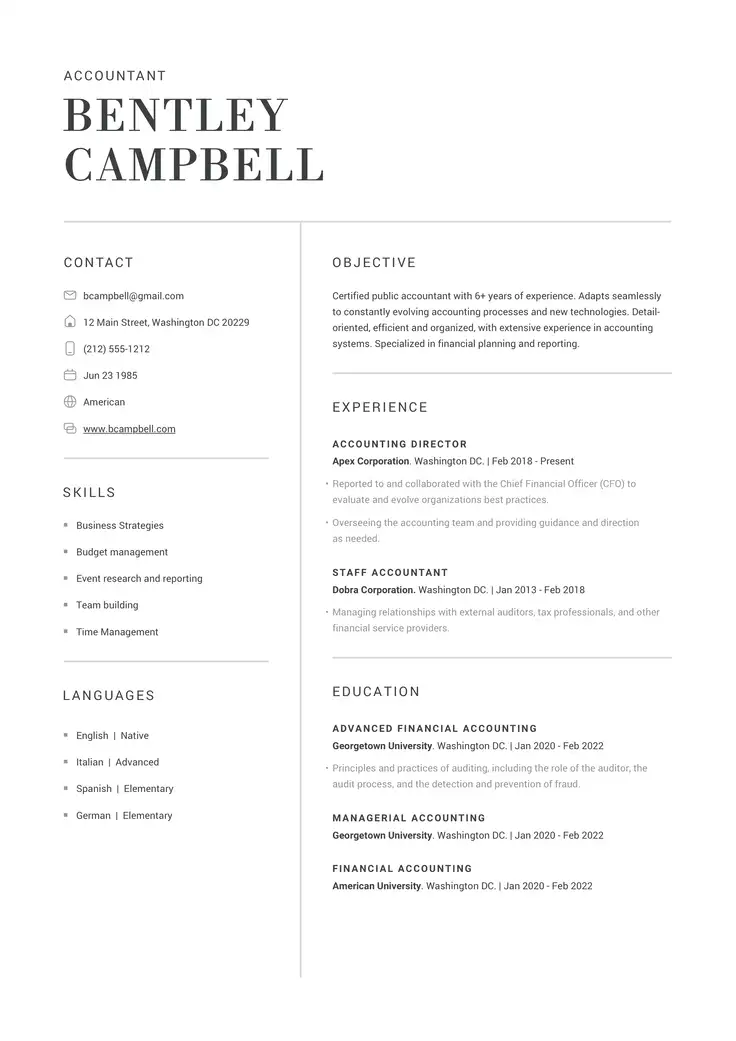- What To Include in Your Education Section
- Where To Position Education on Your Resume
- How To List Your High School Education and GED on Your Resume
- How To Put Graduate-Level Education on Your Resume
- How To List Incomplete or in-Progress Education on a Resume
- How To Add a Degree You Are Not Going To Finish
- How To Add Bootcamps or Other Courses
- Still Looking for Help With Your Education Section?
Ready to write a standout resume? Your education section is key!
Whether you’re diving into a new industry or targeting your dream job, how you present your education can make a big difference.
In this guide, we’ll walk you through the essentials of listing your education on a resume. From high school diplomas to advanced degrees and even courses you’re still completing, we’ve got you covered.
Plus, we’ll make it super simple with plenty of examples.
Let’s get started!
What To Include in Your Education Section
Start by listing your most recent educational achievement first under the “Education” heading, and then work your way back. This is the reverse chronological format favored by most recruiters.
Have an advanced degree? Lead with that, followed by your bachelor’s degree and, if space allows, your high school diploma.
If you’re tight on space and have multiple degrees, feel free to skip the high school details.
You can add bullet points of your academic accomplishments, or you can keep things to the point and simply state the degree, school, location.
The year is most relevant to new graduates. After about 10 years of professional experience, the year is no longer considered as relevant. Some experts have also warned that including it can lead to ageism.
Where To Position Education on Your Resume
Wondering where to place your education on your resume? It depends on the job you’re eyeing and your experience level.
After your name and contact details, your resume should start with an objective statement or summary.
An objective statement is typically used for recent grads, and a summary statement is used for individuals with more in-depth work experience.
Then comes the big question: Should you list education or experience next?
Let’s break it down with 2 scenarios to help you decide.
Where to list education when you are entry-level
Applying for a job that values specific educational credentials? Or maybe you’re just starting out and don’t have much work experience yet? In these cases, putting your education section before your experience, but after your skills section, can make a big impact.
For instance, if you’ve just graduated with a business degree but lack work experience in the field, leading with your education highlights your qualifications without drawing attention to the gaps.
This is especially crucial if you’re targeting roles that require your degree, like finance positions.
You can also add your GPA, awards, extracurriculars, and relevant coursework that connects to the position you’re applying for, as well as the Dean’s List if applicable.
However, pay attention to the skills listed in the job description and only mention coursework that is truly relevant.
Where to list education when you have more than 5 years of experience
With a solid track record in your field, it’s time to let your experience do the talking!
-
💡 Our expert’s advice

Once you have at least 5+ years of experience, it is important to carefully read the job description when deciding where to position your education. If the preferred qualifications require a specific degree, you should list it upfront; otherwise, you may choose to leverage your experience.
If you’re applying for a managerial role in a restaurant and have spent the last decade managing staff, your hands-on experience speaks volumes. Even if you have a hospitality certificate, your practical experience will likely be more compelling to hiring managers.
Remember, while your education is important, your resume should highlight what makes you the best fit for the job. If your experience is your strongest asset, make sure it’s front and center. But don’t forget to include your education further down to show the full scope of your qualifications.
💡top tip
Since professionals who have been working for several years need to keep their resumes concise, there is no need to add GPA, coursework, or extracurriculars in the Education section. Only add them if you have space and they add value to your resume.
How To List Your High School Education and GED on Your Resume
Within the education section of your resume, you can list your GED or high school diploma on your resume, just like you would any other degree or certificate. However, if you have a degree, list it first. Education is listed in reverse chronological order.
You can also put a couple of bullet points beneath your diploma to showcase any academic achievements that are relevant to the job you are pursuing or that you are proud of.
Here’s an example of how to list high school on your resume:
Education
Neegan High School, Raleigh, NC
May 2024
- Relevant courses: AP Computer Science, AP Statistics, AP Macroeconomics, AP Psychology
- Maintained at least 3.8 GPA each of the four years, graduated with High Honors, captain of the volleyball team in junior and senior years, Student Body Vice President, Science Club Treasurer
Listing your high school details and successes shows potential employers that you are dedicated, motivated, and possess a strong work ethic.
If you have a higher education degree (or more than one post-secondary degree), you may want to leave your GED or high school diploma out of the education section.
It will save you some space on the page, and the hiring manager will assume you have your high school equivalency if you have a university or college degree.
How To Put Graduate-Level Education on Your Resume
Now, let’s make your shiny new graduate degree work for you!
If you’ve got stellar grades or won scholarships, don’t be shy—highlight those achievements.
This is especially useful if your experience section is a bit light, which is common when you’re fresh out of school and hunting for your first job.
Start with your highest degree and work your way back to your bachelor’s degree.
Here are 3 examples to show you how to format your education section.
1. Single Degree/Diploma Focus
Let’s start with a single degree. This entry includes some extra bullet points to show some key achievements.
Education
BA Art History | Northeastern College, NY
- Graduated Magnum Cum Laude
- President of the Art Society
- 4.0 GPA
Next, let’s look at listing a single degree without adding any bullets:
Education
Bachelor of Science, Nursing
Grand Bend College, New Jersey
2. Multiple Degrees
Finally, let’s look at how you’d list multiple graduate-level degrees on your resume. These should be listed in reverse chronological order, just like your Experience section. List the highest level of degree first.
Education
Doctorate of Aerospace Engineering | University of Toronto, Ontario
Master of Science in Mechanical Engineering | University of Waterloo, Ontario
Bachelor of Engineering in Mechanical Engineering | Western University, Ontario
If it’s important to the job you’re hoping to land, you could add bullet points explaining what your thesis topic was or what courses you focused on during your degree.
How To List Incomplete or in-Progress Education on a Resume
If you are still in university or college, then you might be wondering how to list your current studies on your resume.
When you list items on your resume chronologically, you start from the most recent and work your way backward.
For degrees or certification courses still in progress, you can note the start date and either “Present” or your expected graduation year. This way, you highlight your current academic pursuits without drawing attention to what’s incomplete.
Employers value knowing what you’re studying, along with any relevant coursework or special achievements related to the job. To effectively list ongoing education on your resume, position the education section right below your contact details and summary statement, especially if you’re still a student.
Here are a few examples of how to list education if you’re still in college
Bachelor of Education, XYZ University, CT2024 – In progress
Bachelor of Education, XYZ University, Expected graduation: June 2026
How To Add a Degree You Are Not Going To Finish
You may have decided not to complete your studies, or perhaps there was a change of circumstances in your life, which means you cannot complete them.
It can still enhance your resume, but you will need to shift the emphasis to the coursework and topics studied, along with any standout achievements.
This will show recruiters that you have still learned valuable skills and gained important knowledge, even if you have not completed the course.
Tailor your educational experience to the job, to emphasize its value.
Education
Bachelor of Education | XYZ University, CT
- Completed coursework: Foundations of Education, Educational Psychology, Curriculum and Instruction, Classroom Management, Literacy and Language Development
- Experience gained in Blackboard Learn, Moodle, Quizlet, and Google Workspace for collaboration.
- Field experience gained in observing elementary school teachers, planning lessons, and assisting with lesson delivery.
-
💡 Our expert’s advice

If it’s an incomplete Doctorate, you can add “ABD”, which means all but dissertation.
How To Add Bootcamps or Other Courses
What about more non-traditional means of training or education, such as bootcamps or online coursework? Is there a spot on your resume for this information?
Yes! By all means, include these details on your resume, particularly if you do not have a lot of experience or lack traditional educational studies.
Bootcamps have become an increasingly popular alternative to earning a college degree, as students spend less time and money compared to four-year or graduate degree programs.
These programs are effective as well; in August 2024, Fortune reported that more than 90% of coding bootcamp graduates found a job within a year after graduation.
If you attended a bootcamp, which are mainly offered in many tech areas such as coding, web development, and software engineering, as well as digital marketing, you have a couple of options for listing this on your resume.
For bootcamps at least six months in length, and that are your main qualification, list this in the Education section. You could highlight any significant projects you completed, along with the name of the bootcamp, dates attended, and any credentials earned.
If you have a degree but want to highlight recent upskilling, create a Certifications & Training section and list the bootcamp, online course, or certificate program there.
Like this:
Education
Coding Bootcamp | FullStack Academy
March 2024 – October 2024
- Tools used: Git, GitHub, VS Code, and Chrome Dev Tools, as well as JavaScript, HTML, SQL
- Wrote and optimized front-end code and built full-stack web applications
- Collaborated with a team to create a real-world full-stack prototype
>>Certifications & Training<<
IBM Full Stack Software Developer Professional Certificate | Coursera
2024
- Focusing on front-end and back-end development languages, application development, and cloud methodologies
- Full Stack JavaScript Certification
Lastly, if the course, bootcamp, or certificate program is highly relevant to the specific job you are applying for, you would mention it in your professional summary or Skills section.
Still Looking for Help With Your Education Section?
Need more guidance on perfecting your resume? Look no further! Our online resume builder is here to help.
You can build your own custom resume to see where exactly to list your education, or you can download our free resume templates for inspiration.
Good luck!
FAQs
To format your education on a resume, start with your most recent degree and work backward. Include the degree type, major, institution name, location, and graduation date. If you’re still studying, mention your expected graduation date.
Highlight any honors, relevant coursework, or extracurricular activities that showcase your skills. For example:
Bachelor of Science in Marketing, ABC University, NY, Expected 2023
Tailor the details to fit the job you’re applying for, emphasizing aspects that align with the role.
To list degrees on a resume, start with your most recent degree and work backward. Include the degree type, major, university name, location, and graduation date. For example:
Master of Science in Computer Science, Stanford University, Stanford, CA, June 2023
If you have multiple degrees, list them in reverse chronological order.
To list expected education on a resume, include the degree you’re pursuing, the institution, location, and your anticipated graduation date:
Bachelor of Arts in Psychology, University of California, Los Angeles, CA, Expected June 2025
This format clearly indicates that you’re currently studying and when you expect to complete your degree, helping employers understand your current academic status.
To list high school on your resume, create an Education section and include the school name, location, and graduation date:
High School Diploma, Patterson Hills High School, Billings, MT, 2022
If you’re still in high school, mention your expected graduation date. Only include your high school education if it’s your highest level of education or if you’re currently a student.
If you have a college degree or significant work experience, you can omit it.
Related posts


